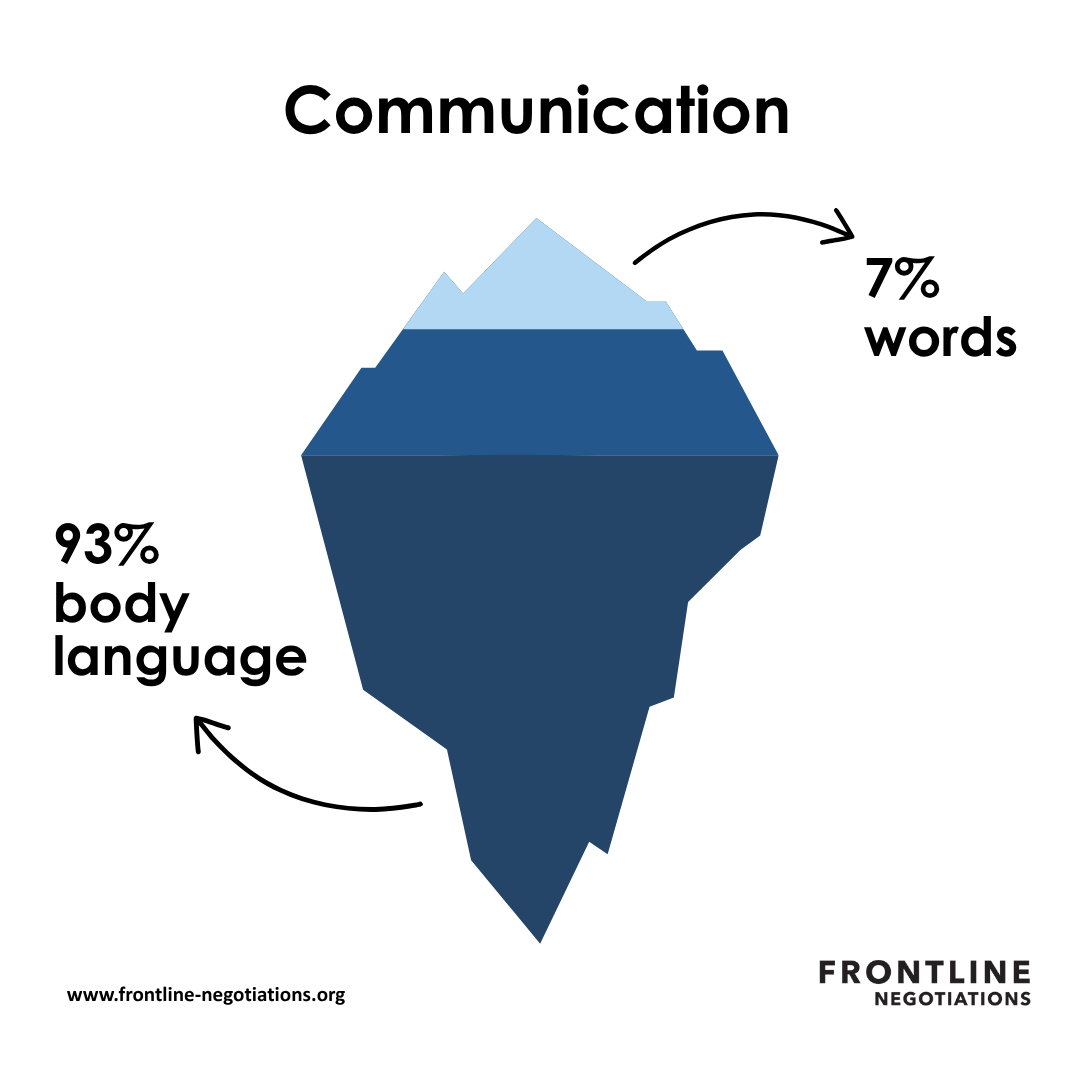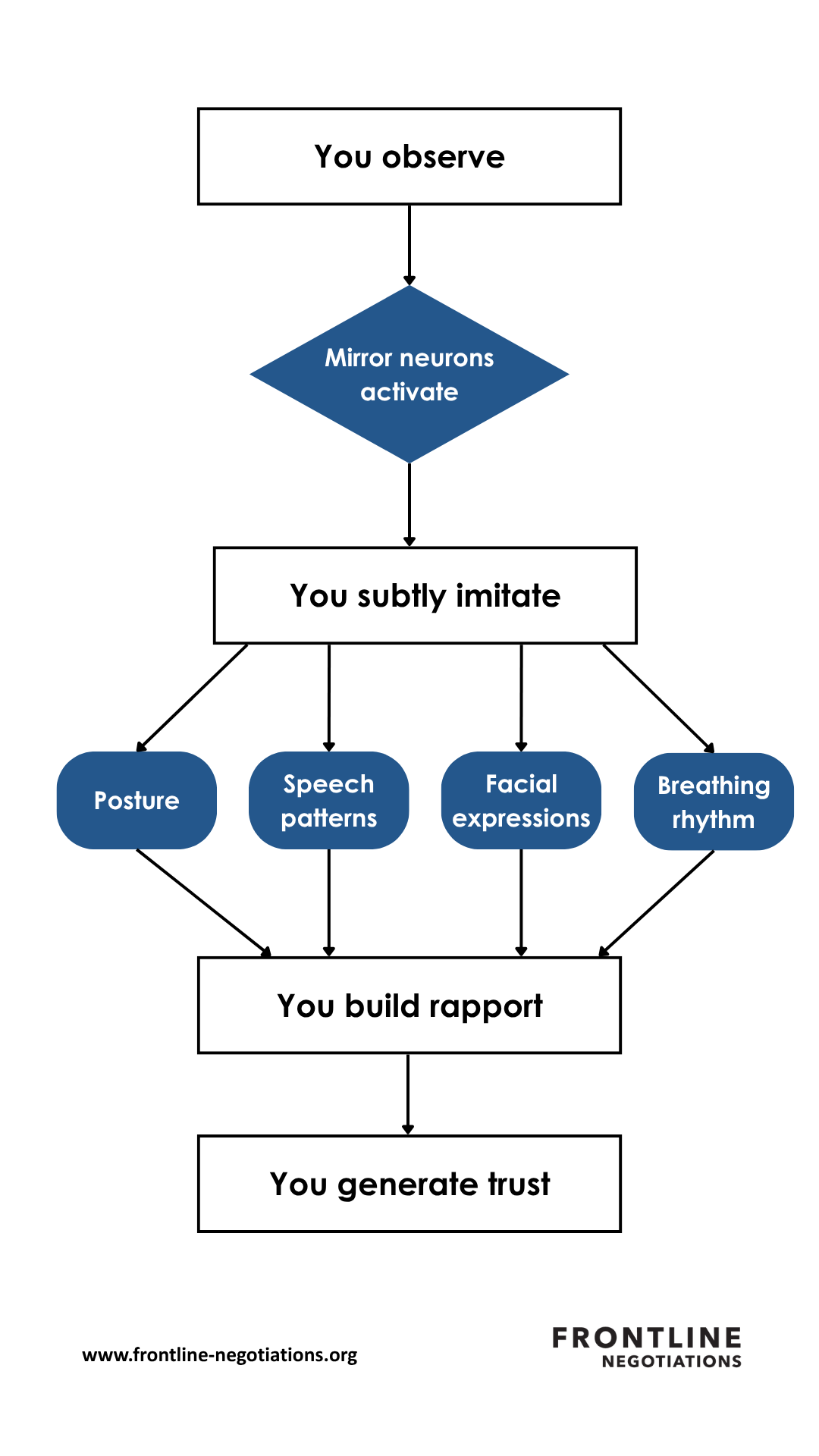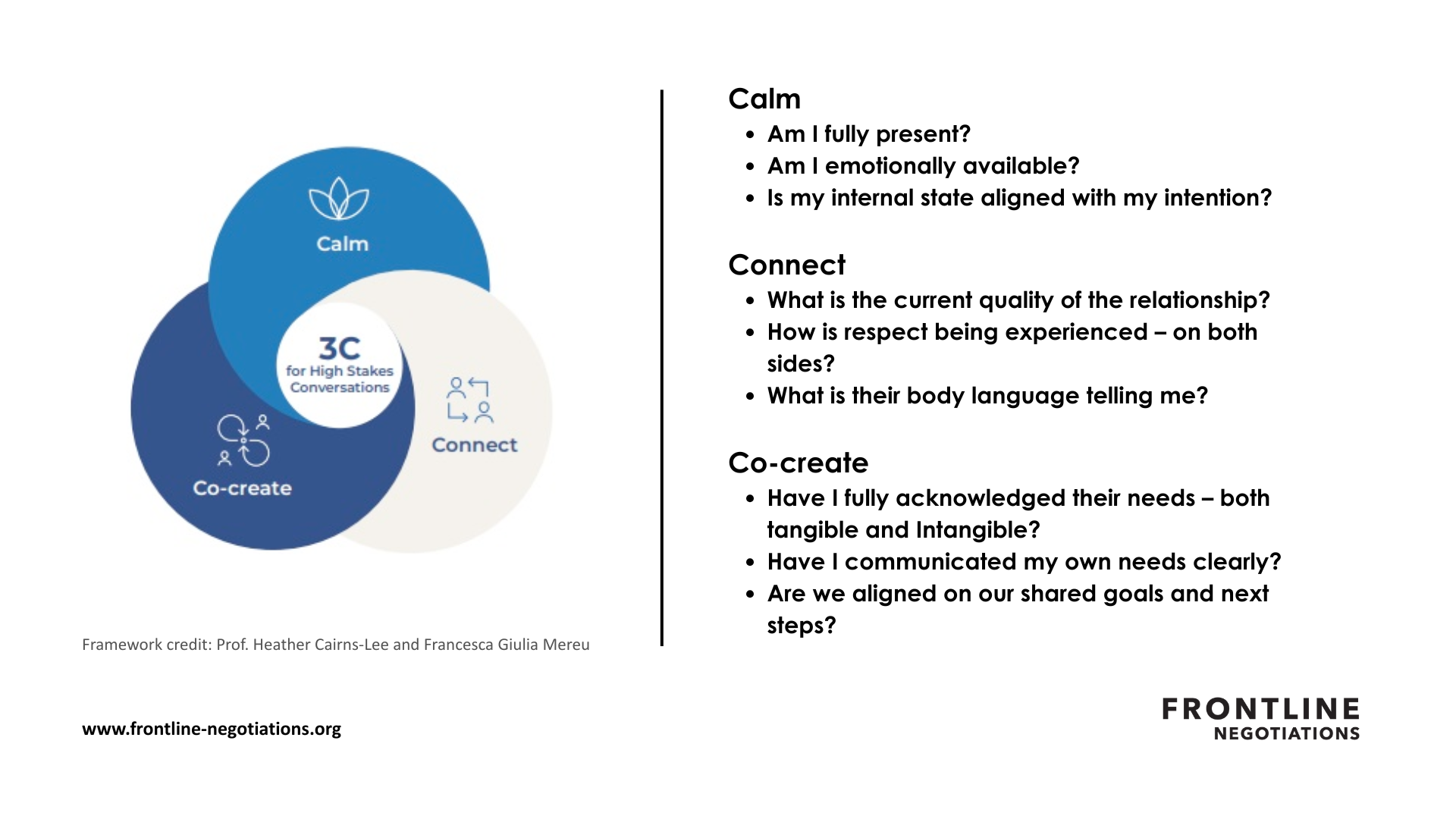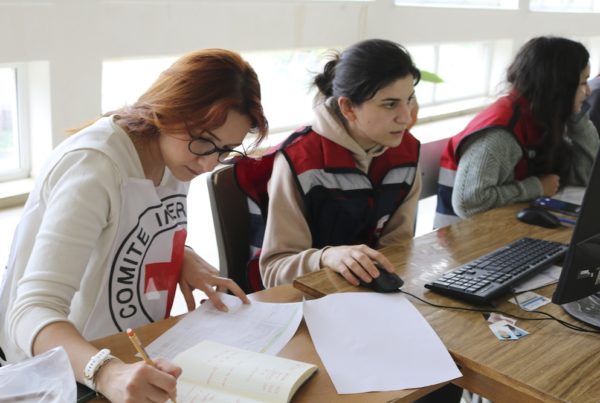
What if the secret to better negotiations was already wired into your brain?
Every day, humanitarian workers sit across from government officials, community leaders, and armed group representatives to negotiate access, secure authorisations, and establish trust. These conversations can mean the difference between life and death for affected populations – which tends to create a lot of pressure on the negotiator and impact the way they act or communicate.
But here’s something that might surprise you: much of what determines negotiation success happens below the level of conscious awareness. Your brain, nervous system, and body language are constantly communicating with your counterpart – and you can learn to use this to your advantage.
Recent advances in neuroscience research reveal that successful negotiation isn’t just about what you say. It’s about how your nervous system interacts with theirs, how you build rapport at a biological level, and how you manage the stress responses that can derail even the most well-prepared discussions.
Why your brain matters in humanitarian negotiations
Think about your last challenging negotiation. Maybe you were trying to secure access to a conflict zone, or convincing a community leader to allow health services in their territory.
How did you feel in your body? Were your shoulders tense? Was your heart racing? Could you think clearly, or did you feel overwhelmed by the stakes?
These physical responses aren’t just side effects of stress – they’re actively shaping the outcome of your negotiation. When your nervous system perceives a threat, it triggers a cascade of biological responses that affect your ability to:
- Communicate clearly and empathetically
- Build trust and rapport with counterparts
- Think creatively about solutions
- Make sound decisions under pressure
Understanding how your nervous system works – and how to influence it – can dramatically improve your negotiation outcomes.
The science behind successful negotiations
Your nervous system's role in communication
Here’s a fascinating fact: only about 7% of communication is the actual words you speak. The rest is tone, body language, volume, and countless other signals bouncing between brains, both conscious and unconscious.
Your nervous systems are literally communicating with each other. When you understand this, you can adapt and adjust to synchronise with your counterpart and move more swiftly toward creative solutions.

The threat detection system
Your brain has an ancient threat detection system that’s constantly scanning for danger. In negotiations, this system can work against you.
When you feel threatened or stressed, your sympathetic nervous system activates the “fight, flight, or freeze” response. This stress response affects your ability to:
- See your counterpart as a potential partner rather than an opponent
- Identify common ground and shared interests
- Access creative problem-solving abilities
- Build new relationships and trust
Most perceptions get filtered as threats to be eliminated or avoided – exactly the opposite of what you want in a good-faith negotiation.
The power of feeling safe
On the flip side, when you feel safe and calm, your parasympathetic nervous system activates the “rest and digest” response. In this state, you naturally:
- Find it easier to relate to others and see them as allies
- Identify commonalities and shared goals
- Access creative thinking and innovative solutions
- Build rapport and trust more easily
The best negotiation outcomes happen when both parties feel safe enough to move from competition to collaboration.
Building rapport through biological synchronisation
Mirror neurons and unconscious mimicry
Your brain contains specialised cells called mirror neurons that activate both when you perform an action and when you observe someone else performing the same action. This creates a natural tendency toward mimicry and synchronisation.
Research shows that humans use unconscious behavioural mimicry when they want to build rapport with others. When you subtly mirror someone’s:
- Body language and posture
- Speaking pace and volume
- Breathing rhythm
- Facial expressions
You trigger their mirror neuron system, creating a sense of connection and similarity. This isn’t manipulation – it’s tapping into a natural human tendency that helps us bond and cooperate.
Emotional contagion in negotiations
Emotions are contagious. When you walk into a negotiation feeling anxious or defensive, your counterpart’s nervous system will likely pick up on these signals and respond accordingly.
But here’s the good news: you can use emotional contagion to your advantage. When you maintain calm, confident energy, you can help regulate your counterpart’s nervous system and create a more collaborative atmosphere.
This is called co-regulation – actively managing your emotional state to facilitate an exchange of calm and trust between you and your counterpart.
Practical strategies for better negotiation outcomes
1. Regulate your emotions before and during negotiations
Your emotional state is the foundation of everything else. Before entering any negotiation:
Name and accept your emotions: What are you feeling? Anxiety about the stakes? Frustration with past interactions? Pressure from your organisation?
Reframe negative thoughts: Instead of “They’ll never agree to this,” try “I’m curious to understand their perspective.”
Use breathing techniques: Deep, slow breathing activates your parasympathetic nervous system and helps you stay calm.
Ground yourself physically: Feel your feet on the floor, notice your surroundings, and remind yourself that you’re safe.


Heather Cairns-Lee, Affiliate Professor, Leadership and Communication, IMD
Francesca Giulia Mereu, Executive Coach
“Preparation for high-stakes conversations is often focused on tactics, agendas, and desired outcomes. Yet, the ability to leverage these tactics is based on our ability to remain present and focused. Practical techniques to manage your emotional and physiological state include conscious breathing and mindful self-talk that regulate your nervous system […]. This neurosequence slows your heart rate, reduces cortisol levels, and allows the prefrontal cortex, the centre for rational thinking, decision-making, and impulse control, to remain engaged.”
2. Build rapport through strategic mirroring
Once you’re in the negotiation, you can use mirroring to build connection:
Match their communication style: If they speak slowly and thoughtfully, slow down your pace. If they’re more animated, you can increase your energy level.
Mirror their body language: Subtly adopt similar postures, but don’t copy them exactly – that can feel artificial.
Synchronise your breathing: This is particularly powerful for creating a sense of calm and connection.
Use similar language patterns: If they use formal language, match their tone. If they’re more casual, you can be too.
3. Create psychological safety for both parties
Remember, your counterpart’s nervous system is also scanning for threats. You can help them feel safe by:
Being transparent about your humanitarian purpose: Clearly state why you’re there and what you hope to achieve for affected populations.
Acknowledging their position: Recognise the pressures and constraints they’re facing.
Finding common ground: Look for shared values, mutual concerns, or areas of agreement.
Avoiding confrontational language: Use “we” instead of “you” when discussing problems or challenges.
4. Manage stress responses in high-pressure situations
Humanitarian negotiations often involve high stakes and tight deadlines. When stress levels rise:
Take breaks: If tensions escalate, suggest a short break to let everyone’s nervous systems reset.
Use grounding techniques: Focus on your breath, feel your feet on the ground, or notice five things you can see in the room.
Reframe the situation: Instead of seeing conflict as threatening, view it as information about underlying needs and interests.
Stay focused on the humanitarian purpose: Remember why you’re there and what’s at stake for affected populations.
5. Use your voice and body language strategically
Your tone of voice and physical presence communicate as much as your words:
Speak slowly and clearly: This conveys confidence and helps both parties process information better.
Use a lower, calmer tone: High-pitched or fast speech can signal stress and anxiety.
Maintain open body language: Uncrossed arms, relaxed shoulders, and appropriate eye contact all signal safety and openness.
Match their energy level: If they’re speaking quietly, don’t overwhelm them with high energy. If they’re more animated, you can match that enthusiasm.


Heather Cairns-Lee, Affiliate Professor, Leadership and Communication, IMD
Francesca Giulia Mereu, Executive Coach
“We created a simple yet powerful framework to make sense of the behaviours and dynamics at play in complex, high-pressure interactions: the ‘3-Cs’ framework, which stands for ‘calm, connect, and co-create.’ These steps are based on the neurosequential model of the brain and help people make sense of these charged, complex, and potentially volatile conversations by opening the window of tolerance, enabling people to navigate the emotional landscape of high-stakes conversations and choose productive behaviours. The ‘3-Cs’ framework initially emerged from our work with frontline humanitarian negotiators at the Centre of Competence on Humanitarian Negotiation (CCHN).”
The 3-C's framwork for high-stakes conversations
The evolution of cooperation in humanitarian work
Understanding why humans cooperate at all helps explain why these neuroscience principles work so well in negotiations.
Humans evolved as a cooperative species. Unlike many other animals, we regularly sacrifice individual gain for group benefit.
This tendency toward cooperation is built into our nervous systems and social behaviour.
However, we also have a natural tendency to trust those who are similar to us and be wary of those who seem different or outside our circle of trust.
Humanitarian negotiations often involve building trust with people who may initially see you as an outsider. The neuroscience techniques we’ve discussed help you:
- Signal that you’re trustworthy and safe
- Find commonalities despite surface differences
- Tap into natural human tendencies toward cooperation
- Create conditions where collaborative solutions can emerge
Real-world application: A case study approach
Let’s look at how these principles might work in practice:
The situation: You’re negotiating with a local authority for permission to establish a health clinic in a conflict-affected area. Previous attempts by other organisations have been unsuccessful.
Traditional approach: Present your proposal, explain the benefits, and hope for approval.
Neuroscience-informed approach:
- Before the meeting: Regulate your own nervous system through breathing exercises and positive visualisation.
- Opening moments: Focus on building rapport through mirroring their communication style and finding common ground around shared concern for community health.
- During the discussion: Monitor both your stress levels and theirs. If tension rises, acknowledge their concerns and take a collaborative approach to problem-solving.
- Managing objections: Instead of becoming defensive, use their concerns as information about their underlying needs and interests.
- Building toward agreement: Create a sense of partnership by using “we” language and emphasising shared goals.


Heather Cairns-Lee, Affiliate Professor, Leadership and Communication, IMD
Francesca Giulia Mereu, Executive Coach
“Connection is not just a one-time step; it is a continuous practice throughout the conversation. Just as we state to regulate our state, it helps to stay attuned to how others may be under pressure as well. Without this awareness, dialogue can quickly devolve into power struggles, with both parties focused on defending their positions rather than seeking to understand each other.”
Common challenges and how to address them
When your counterpart seems hostile or defensive
What’s happening: Their nervous system has likely identified you as a threat.
Neuroscience response: Focus on co-regulation. Stay calm, speak slowly, and use non-threatening body language. Don’t try to convince them immediately – first help them feel safe.
When negotiations stall or become repetitive
What’s happening: Both parties may be stuck in stress response patterns that limit creative thinking.
Neuroscience response: Suggest a break, change the physical environment, or try a different approach that engages different parts of the brain.
When you feel overwhelmed by the stakes
What’s happening: Your own stress response is interfering with your ability to negotiate effectively.
Neuroscience response: Use grounding techniques, remind yourself of your humanitarian purpose, and focus on breathing to activate your parasympathetic nervous system.
When cultural differences create barriers
What’s happening: Different cultural norms around communication, hierarchy, or decision-making may be creating unconscious friction.
Neuroscience response: Pay extra attention to mirroring their communication style, show respect for their cultural norms, and look for universal human needs and emotions.
Building long-term relationships through neuroscience
The principles of neuroscience don’t just help in individual negotiations – they can help you build stronger, more effective relationships with all your counterparts over time.
Creating positive associations
Every interaction you have with a counterpart creates neural pathways in their brain. When you consistently:
- Help them feel safe and respected
- Find solutions that meet their needs
- Follow through on commitments
- Communicate with empathy and understanding
You’re literally rewiring their brain to associate you with positive outcomes and trust.
Developing your reputation as a collaborative partner
In humanitarian contexts, your reputation often precedes you. When you consistently use neuroscience-informed approaches, you develop a reputation as someone who:
- Can be trusted to find win-win solutions
- Remains calm under pressure
- Understands and respects different perspectives
- Delivers on promises and commitments
This reputation becomes a powerful asset in future negotiations.
The future of humanitarian negotiation
As our understanding of neuroscience advances, we’re discovering more ways to improve human cooperation and communication. For humanitarian workers, this means:
Better training programs: Incorporating neuroscience principles into negotiation training can help humanitarian workers develop more effective skills.
Improved stress management: Understanding how stress affects negotiation can help organisations support their staff better.
More effective relationship building: Knowing how trust and rapport develop at a biological level can help humanitarian actors build stronger partnerships.
Creative problem-solving: Understanding how the brain generates creative solutions can help negotiators find innovative approaches to complex challenges.
Remember…
Your brain and nervous system are powerful tools for building connection, trust, and cooperation. By understanding how they work, you can:
- Improve your negotiation outcomes
- Build stronger relationships with counterparts
- Manage stress more effectively
- Find creative solutions to complex problems
- Serve affected populations more effectively
The science is clear: successful negotiation isn’t just about what you say – it’s about how you show up, how you make others feel, and how you create conditions for collaboration.
Your next negotiation might be challenging, but remember that you have millions of years of evolution on your side. Humans are wired to cooperate, build trust, and find solutions together.
Use that to your advantage. Good luck!
This blog post draws on research from neuroscience, psychology, and humanitarian practice. For more detailed information about the science behind these approaches, see the references and resources section below.
References and further reading
- Neuroscience of negotiation: Psychology Today – The neuroscience of negotiation research
- Mirror neurons and rapport building: Ohio State University research on nonconscious behavioural mimicry
- Emotional contagion: Harvard research on co-regulation and emotional states
- Stress response and decision-making: Harvard Health – Understanding the stress response
- Evolution of cooperation: Research on human cooperation and altruism
- Negotiation and neuroscience for negotiation instruction: Program on Negotiation at Harvard Law School
- Nonverbal communication: Psychology Today – The body language myth






